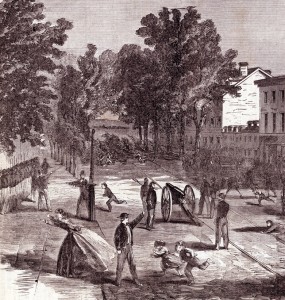Shelling of Carlisle, Pennsylvania
William E. Miller, Local History: Troops Occupying Carlisle, July, 1863 (Carlisle, PA: Hamilton Library Association, 1902).
William E. Miller’s essay offers an overview of the events surrounding the Confederates’ occupation of Carlisle, Pennsylvania in 1863. Miller describes in detail the Confederate advance through Pennsylvania in June 1863 and provides the order of battle for Confederate General Richard S. Ewell’s second corps. In addition, the essay includes an article (“Came Near Being Hung: What Happened to Two Cumberland Countians in the Rebel Invasion”) that was originally published in the Carlisle (PA) American Volunteer.
James W. Sullivan, Boyhood Memories of the Civil War 1861-’65: Invasion of Carlisle (Carlisle, PA: Hamilton Library Association, 1933).
While in Hereford, England in July 1932, J. W. Sullivan writes a letter to a family friend and recalls his experiences in Carlisle, Pennsylvania during the Civil War and other related topics. Before the war Sullivan notes that political tensions were high. “From my earliest years I was accustomed to hearing among our neighbors the high notes of political arguing,” as Sullivan explains. Sullivan was 13 when Confederates attacked Fort Sumter in April 1861 and he provides an overview of what happened in Carlisle during the war as well as how the community reacted to news from the front. In addition, Sullivan offers a detailed account of the Confederate shelling of Carlisle in 1860. Sullivan also reflects on the ways that Americans commemorated the Civil War, including visiting Gettysburg and the establishment of the Grand Army of the Republic.
Charles Gilbert Beetem, Experiences of a West Ward Boy (Carlisle, PA: Hamilton Library Association, 1963).
Charles Gilbert Beetem’s article discusses James W. Sullivan’s recollection of the Confederate Invasion of Carlisle. (Sullivan’s original account was published in 1933 and has also been posted on Library Divided). Even though “there was far more action around the Public Square and in Carlisle’s eastern parts,” Beetem notes that this account from someone who lived in the West Ward remains an “interesting” story. Beetem includes excerpts from Sullivan’s letter and provides additional information about people and events in Sullivan’s account.
Robert Grant Crist, Confederate Invasion of the West Shore – 1863 (Carlisle, PA: Hamilton Library Association, 1963).
Robert Grant Crist provides a detailed overview of the Confederate advance in June 1863 to the West Shore of the Susquehanna River in Pennsylvania. His article ends with the Confederate withdrawal from Mechanicsburg, Pennsylvania on June 30. While “Harrisburg was safe,” Crist notes that “the storm was about to break in Adams County.” Crist uses a wide range of materials to write his account, from Pennslyvania nad New York newspapers to solders’ letters and the Official Records. His essay also includes several photographs and maps.
George M. Diffenderfer, Notes on Rebel Routes and Artillery (Carlisle, PA: Hamilton Library Association, 1963).
George M. Diffenderfer’s essay discusses several questions about Confederate artillery units that participated in the shelling of Carlisle on July 1, 1863. After explaining why Confederates shelled the town, Diffenderfer reviews military records to determine how many cannons were involved, the location of artillery during the bombardment, and the number of times that Confederate artillery fired.
Milton E. Flower, Wednesday, July 1st 1863 (Carlisle, PA: Hamilton Library Association, 1963).
Milton E. Flower’s short essay offers a relatively concise overview of the events that took place in Carlisle on July 1, 1863.
James D. Flower, “Physical Remains of the Confederate Invasion of 1863,” Cumberland County History 15 (1998): 73-78.
Even though Confederates invaded Pennsylvania in 1863, James D. Flower explains that one can still find physical remains from that event today. Flower describes several places in Carlisle that were damaged when Confederates shelled the town as well as the remains of two defensive fortifications (Fort Couch and Fort Washington). The essay includes photographs of these locations.
Simpson K. Donavin, “The Invasion: Rebel Occupancy of Carlisle, 1863,” Cumberland County History 15 (1998): 34-50.
Simpson K. Donavin’s account of the Confederate’s operation in Carlisle, Pennsylvania was originally published in July 1863 in three local papers (American Volunteer ; Carlisle Herald ; Carlisle American). As Confederates approached Shippensburg, Carlisle residents began to realize that General Robert E. Lee’s advance was a major operation. “The threats so often made by the Southern papers were to assume reality, and the States of Maryland and Pennsylvania were indeed to be made the battle-field,” as Donavin explained. As Confederates entered Carlisle on June 27, 1863, Donavin recalled that “every man carried his gun to a position to use it on the instant with his hand on the hammer.” Donavin described in detail what happened between this initial encounter and the Confederate shelling of the town on July 1, 1863. Historians have been unable to figure out many details about Donavin’s life before or after this article appeared in July 1863. This essay also includes several photographs.
Barbara Houston, “Narrow Escapes: Two Original Accounts of Civil War Shells in the Hands of Carlisle Civilians After the War,” Cumberland County History 24 (2007): 48-52.
Barbara Houston’s article includes two accounts of Carlisle residents’ encounters with unexploded artillery shells after the Civil War. Frank Wetzel recalled one incident that involved a Civil War veteran who worked at his father’s shop on North Bedford Street. In addition, an article from the Carlisle (PA) Herald described what happened at a house on South Hanover Street in May 1868 after a conical shell was accidentally “shoveled into a bucket of coal and from thence carried to the cook stove where the contents of the bucket were thrown upon the fire.”
These essays have been posted online with permission from the Cumberland County Historical Society.

Leave a Reply